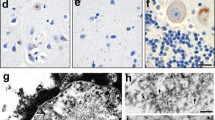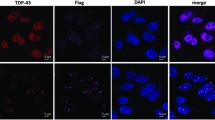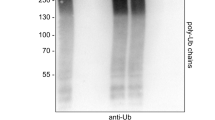Abstract
Human tetratricopeptide repeat domain 3 (TTC3) is a gene on 21q22.2 within the Down syndrome critical region (DSCR). Earlier studies suggest that TTC3 may be an important regulator in individual development, especially in neural development. As an E3 ligase, TTC3 binds to phosphorylated Akt and silence its activity via proteasomal cascade. Several groups also reported the involvement of TTC3 in familial Alzheimer’s disease recently. In addition, our previous work shows that TTC3 also regulates the degradation of DNA polymerase gamma and over-expressed TTC3 protein tends to form insoluble aggregates in cells. In this study, we focus on the solubility and intracellular localization of TTC3 protein. Over-expressed TTC3 tends to form insoluble aggregates over time. The proteasome inhibitor MG132 treatment resulted in more TTC3 aggregates in a short period of time. We fused the fluorescent protein to either terminus of the TTC3 protein and found that the intracellular localization of fluorescent signals are different between the N-terminal tagged and C-terminal tagged proteins. Western blotting revealed that the TTC3 protein is cleaved into fragments of different sizes at multiple sites. The N-terminal sub-fragments of TTC3 are prone to from nuclear aggregates and the TTC3 nuclear import is mediated by signals within the N-terminal 1 to 650 residues. Moreover, over-expressed TTC3 induced a considerable degree of cytotoxicity, and its N-terminal sub-fragments are more potent inhibitors of cell proliferation than full-length protein. Considering the prevalent proteostasis dysregulation in neurodegenerative diseases, these findings may relate to the pathology of such diseases.





Similar content being viewed by others
References
Antonarakis, S. E., Lyle, R., Dermitzakis, E. T., Reymond, A., & Deutsch, S. (2004). Chromosome 21 and Down syndrome: From genomics to pathophysiology. Nature Reviews Genetics, 5(10), 725–738.
Berto, G., Camera, P., Fusco, C., Imarisio, S., Ambrogio, C., Chiarle, R., et al. (2007). The Down syndrome critical region protein TTC3 inhibits neuronal differentiation via RhoA and Citron kinase. Journal of Cell Science, 120(11), 1859–1867.
Blandini, F., Sinforiani, E., Pacchetti, C., Samuele, A., Bazzini, E., Zangaglia, R., et al. (2006). Peripheral proteasome and caspase activity in Parkinson disease and Alzheimer disease. Neurology, 66(4), 529–534.
Brameier, M., Krings, A., & Maccallum, R. M. (2007). NucPred—Predicting nuclear localization of proteins. Bioinformatics, 23(9), 1159–1160.
Capkova, P., Misovicova, N., & Vrbicka, D. (2014). Partial trisomy and tetrasomy of chromosome 21 without Down Syndrome phenotype and short overview of genotype-phenotype correlation. A case report. Biomed Pap Med Fac Univ Palacky Olomouc Czech Repub, 158(2), 321–325.
Dahmane, N., Ghezala, G. A., Gosset, P., Chamoun, Z., Dufresne-Zacharia, M. C., Lopes, C., et al. (1998). Transcriptional map of the 2.5-Mb CBR-ERG region of chromosome 21 involved in Down syndrome. Genomics, 48(1), 12–23.
Delabar, J. M., Theophile, D., Rahmani, Z., Chettouh, Z., Blouin, J. L., Prieur, M., et al. (1993). Molecular mapping of twenty-four features of Down syndrome on chromosome 21. European Journal of Human Genetics, 1(2), 114.
Farrell, C. M., Leary, N. A. O., Harte, R. A., Loveland, J., Wilming, L., Wallin, C., et al. (2014). Current status and new features of the Consensus Coding Sequence database. Nucleic Acids Research, 42, 865–872.
Ferreira, A. (2012). Calpain dysregulation in Alzheimer’s disease. International Scholarly Research Notices, 2012, 728571–728571.
Gamblin, T. C., Chen, F., Zambrano, A., Abraha, A., Lagalwar, S., Guillozet, A. L., et al. (2003). Caspase cleavage of tau: Linking amyloid and neurofibrillary tangles in Alzheimer’s disease. Proceedings of the National Academy of Sciences of the United States of America, 100(17), 10032–10037.
Gong, Y., Wang, X., Shang, X., Xiao, S. P., Li, W., Shang, Y., et al. (2017). Tetratricopeptide repeat domain 3 overexpression tends to form aggregates and inhibit ubiquitination and degradation of DNA polymerase γ. Oncotarget, 8(63), 106475–106485.
Harte, R. A., Farrell, C. M., Loveland, J. E., Suner, M.-M., Wilming, L., Aken, B., et al. (2012). Tracking and coordinating an international curation effort for the CCDS Project. Database: The Journal of Biological Databases and Curation, 2012, bas008. https://doi.org/10.1093/database/bas008.
Hyman, B. T. (2011). Caspase activation without apoptosis: Insight into Aβ initiation of neurodegeneration. Nature Neuroscience, 14(1), 5–6.
Kohli, M. A., Cukier, H. N., Hamiltonnelson, K. L., Rolati, S., Kunkle, B. W., Whitehead, P. L., et al. (2016). Segregation of a rare TTC3 variant in an extended family with late-onset Alzheimer disease. Neurology Genetics. 2(1).
Korenberg, J. R., Chen, X. N., Schipper, R., Sun, Z., Gonsky, R., Gerwehr, S., et al. (1994). Down syndrome phenotypes: The consequences of chromosomal imbalance. Proceedings of the National Academy of Sciences of the United States of America, 91(11), 4997–5001.
Kosugi, S., Hasebe, M., Tomita, M., & Yanagawa, H. (2009). Systematic identification of cell cycle-dependent yeast nucleocytoplasmic shuttling proteins by prediction of composite motifs. Proceedings of the National Academy of Sciences of the United States of America, 106(25), 10171–1017.
Lam, Y. A., Pickart, C. M., Alban, A., Landon, M., Jamieson, C., Ramage, R., et al. (2000). Inhibition of the ubiquitin-proteasome system in Alzheimer’s disease. Proceedings of the National Academy of Sciences of the United States of America, 97(18), 9902–9906.
Lopes, C., Rachidi, M., Gassanova, S., Sinet, P. M., & Delabar, J. M. (1999). Developmentally regulated expression of mtprd, the murine ortholog of tprd, a gene from the Down syndrome chromosomal region 1. Mechanisms of Development, 84(1–2), 189.
Mann, D. M. A. (1988). Alzheimer’s disease and Down’s syndrome. Histopathology, 13(2), 125–137.
Nilsson, E., Alafuzoff, I., Blennow, K., Blomgren, K., Hall, C. M., Janson, I., et al. (1990). Calpain and calpastatin in normal and alzheimer-degenerated human brain tissue. Neurobiology of Aging, 11(4), 425–431.
Ohira, M., Ootsuyama, A., Suzuki, E., Ichikawa, H., Seki, N., Nagase, T., et al. (1996). Identification of a novel human gene containing the tetratricopeptide repeat domain from the Down syndrome region of chromosome 21. DNA Research, 3(1), 9–16.
Oromendia, A., & Amon, A. (2014). Aneuploidy: Implications for protein homeostasis and disease. Disease Models & Mechanisms, 7(1), 15–20.
Pruitt, K. D., Harrow, J., Harte, R. A., Wallin, C., Diekhans, M., Maglott, D., et al. (2009). The consensus coding sequence (CCDS) project: Identifying a common protein-coding gene set for the human and mouse genomes. Genome Research, 19(7), 1316–1323.
Rachidi, M., Lopes, C., Gassanova, S., Sinet, P. M., Vekemans, M., Attie, T., et al. (2000). Regional and cellular specificity of the expression of TPRD, the tetratricopeptide Down syndrome gene, during human embryonic development. Mechanisms of Development, 93(1), 189–193.
Stingele, S., Stoehr, G., Peplowska, K., Cox, J., Mann, M., & Storchova, Z. (2012). Global analysis of genome, transcriptome and proteome reveals the response to aneuploidy in human cells. Molecular Systems Biology, 8(1), 608–608.
Suizu, F., Hiramuki, Y., Okumura, F., Matsuda, M., Okumura, A., Hirata, N., et al. (2009). The E3 ligase TTC3 facilitates ubiquitination and degradation of phosphorylated Akt. Developmental Cell, 17(6), 800–810.
Tsukahara, F., Hattori, M., Muraki, T., & Sakaki, Y. (1996). Identification and cloning of a novel cDNA belonging to tetratricopeptide repeat gene family from Down syndrome–critical region 21q22.2. Journal of Biochemistry, 120(4), 820–827.
Tsukahara, F., Urakawa, I., Hattori, M., Hirai, M., Ohba, K., Yoshioka, T., et al. (1998). Molecular characterization of the mouse mtprd gene, a homologue of human TPRD: Unique gene expression suggesting its critical role in the pathophysiology of Down syndrome. Journal of Biochemistry, 123(6), 1055–1063.
Acknowledgements
The authors will appreciate the support from Experimental Technology Center for Life Sciences, College of Life Sciences, BNU.
Funding
This work was supported by grants from the National Natural Science Foundation of China (NSFC) (31370768, 30970610) and the Open Research Fund of the State Key Laboratory of Cognitive Neuroscience and Learning.
Author information
Authors and Affiliations
Contributions
FD and YG conceived and designed the study. YG, KW, S-PX and PM performed the experiments. FD and YG wrote the paper. FD, WL and YS reviewed and edited the manuscript. All authors read and approved the manuscript. YG and KW contributed equally to this work.
Corresponding author
Ethics declarations
Conflict of interest
The authors declare that they have no competing interests.
Glossary and Abbreviation
- Sub-fragment
-
The artificially designated fragment which covers a certain region of TTC3 protein and is constructed into expression vectors.
- Proteolytic fragment
-
The proteolytic product of full-length TTC3 or its sub-fragments. Full-length TTC3 and the sub-fragments are cleaved by the intracellular proteases.
- N-terminal fragment
-
The fragment which primarily covers the region near the N-terminus of full-length TTC3 protein.
- C-terminal fragment
-
The fragment which primarily covers the region near the C-terminus of full-length TTC3 protein.
- N-terminal tag
-
The tag peptide which is fused to the N-terminus of full-length TTC3 or its sub fragments.
- C-terminal tag
-
The tag peptide which is fused to the C-terminus of full-length TTC3 or its sub fragments.
- N-terminal fluorescent signal
-
The fluorescent signal which is derived from the N-terminal tag or fluorescent protein fused to the N-terminus of full-length TTC3 or its sub-fragments.
- C-terminal fluorescent signal
-
The fluorescent signal which is derived from the C-terminal tag or fluorescent protein fused to the C-terminus of full-length TTC3 or its sub-fragments.
- RIPAs
-
The RIPA-soluble components of the cells. The cells are lysed with RIPA buffer, and the supernatant is obtained after centrifugation.
- RIPAp
-
The pellets. After centrifugation, the RIPA-insoluble components were made into pellets.
Rights and permissions
About this article
Cite this article
Gong, Y., Wang, K., Xiao, SP. et al. Overexpressed TTC3 Protein Tends to be Cleaved into Fragments and Form Aggregates in the Nucleus. Neuromol Med 21, 85–96 (2019). https://doi.org/10.1007/s12017-018-8509-7
Received:
Accepted:
Published:
Issue Date:
DOI: https://doi.org/10.1007/s12017-018-8509-7




